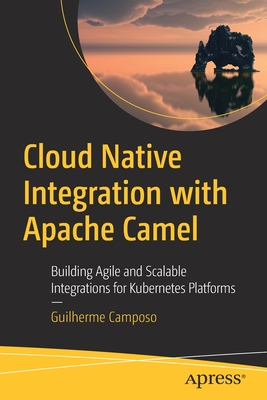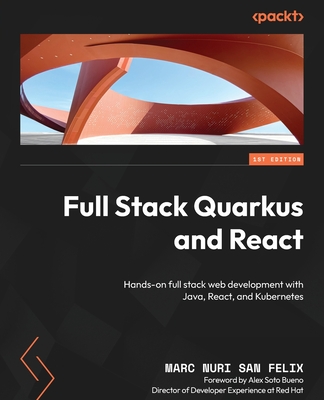Cloud Native Integration with Apache Camel: Building Agile and Scalable Integrations for Kubernetes Platforms
暫譯: 雲原生整合與 Apache Camel:為 Kubernetes 平台構建靈活且可擴展的整合解決方案
Camposo, Guilherme
- 出版商: Apress
- 出版日期: 2021-08-26
- 售價: $2,360
- 貴賓價: 9.5 折 $2,242
- 語言: 英文
- 頁數: 250
- 裝訂: Quality Paper - also called trade paper
- ISBN: 1484272102
- ISBN-13: 9781484272107
-
相關分類:
Microservices 微服務
海外代購書籍(需單獨結帳)
買這商品的人也買了...
-
 無瑕的程式碼-敏捷完整篇-物件導向原則、設計模式與 C# 實踐 (Agile principles, patterns, and practices in C#)
無瑕的程式碼-敏捷完整篇-物件導向原則、設計模式與 C# 實踐 (Agile principles, patterns, and practices in C#)$790$616 -
 Working Effectively with Legacy Code : 管理、修改、重構遺留程式碼的藝術 (中文版)
Working Effectively with Legacy Code : 管理、修改、重構遺留程式碼的藝術 (中文版)$720$562 -
 $477Rust 權威指南 (The Rust Programming Language (Covers Rust 2018))
$477Rust 權威指南 (The Rust Programming Language (Covers Rust 2018)) -
 再強一點:用 Go語言完成六個大型專案
再強一點:用 Go語言完成六個大型專案$780$616 -
 $1,400Network Programming with Go: Learn to Code Secure and Reliable Network Services from Scratch
$1,400Network Programming with Go: Learn to Code Secure and Reliable Network Services from Scratch -
 WebSecurity 網站滲透測試:Burp Suite 完全學習指南 (iT邦幫忙鐵人賽系列書)
WebSecurity 網站滲透測試:Burp Suite 完全學習指南 (iT邦幫忙鐵人賽系列書)$600$510 -
 黑帽 Python|給駭客與滲透測試者的 Python 開發指南, 2/e (Black Hat Python : Python Programming for Hackers and Pentesters, 2/e)
黑帽 Python|給駭客與滲透測試者的 Python 開發指南, 2/e (Black Hat Python : Python Programming for Hackers and Pentesters, 2/e)$450$356 -
 Spring REST API 開發與測試指南|使用 Swagger、HATEOAS、JUnit、Mockito、PowerMock、Spring Test
Spring REST API 開發與測試指南|使用 Swagger、HATEOAS、JUnit、Mockito、PowerMock、Spring Test$580$493 -
 Linux 網路內功修煉 - 徹底了解底層原理及高性能架構
Linux 網路內功修煉 - 徹底了解底層原理及高性能架構$780$663 -
 演算法生存指南(書況差限門市銷售)
演算法生存指南(書況差限門市銷售)$800$632 -
 從 Hooks 開始,讓你的網頁 React 起來 (第二版)(iT邦幫忙鐵人賽系列書)
從 Hooks 開始,讓你的網頁 React 起來 (第二版)(iT邦幫忙鐵人賽系列書)$720$562 -
 The Rust Programming Language, 2/e (Paperback)
The Rust Programming Language, 2/e (Paperback)$1,800$1,710 -
 哎呀!原來 React 這麼有趣好玩:圈叉、貪吃蛇、記憶方塊三款經典遊戲實戰練習(iThome鐵人賽系列書)
哎呀!原來 React 這麼有趣好玩:圈叉、貪吃蛇、記憶方塊三款經典遊戲實戰練習(iThome鐵人賽系列書)$620$484 -
 Smaller C|用於小型機器之精實程式碼 (Smaller C: Lean Code for Small Machines)
Smaller C|用於小型機器之精實程式碼 (Smaller C: Lean Code for Small Machines)$680$537 -
 白話機器學習
白話機器學習$780$616 -
 React 思維進化:一次打破常見的觀念誤解,躍升專業前端開發者(iThome鐵人賽系列書)【軟精裝】
React 思維進化:一次打破常見的觀念誤解,躍升專業前端開發者(iThome鐵人賽系列書)【軟精裝】$790$616 -
 Python 風格徹底研究|超詳實、好理解的 Python 必學主題 (Dead Simple Python)
Python 風格徹底研究|超詳實、好理解的 Python 必學主題 (Dead Simple Python)$980$774 -
 遞迴演算法大師親授面試心法:Python 與 JavaScript 解題全攻略 (The Recursive Book of Recursion)
遞迴演算法大師親授面試心法:Python 與 JavaScript 解題全攻略 (The Recursive Book of Recursion)$680$530 -
 建構機器學習系統實踐指南
建構機器學習系統實踐指南$620$490 -
 機器學習的訓練資料 (Training Data for Machine Learning)
機器學習的訓練資料 (Training Data for Machine Learning)$780$616 -
 資料工程基礎|規劃和建構強大、穩健的資料系統 (Fundamentals of Data Engineering)
資料工程基礎|規劃和建構強大、穩健的資料系統 (Fundamentals of Data Engineering)$980$774 -
 讓 AI 好好說話!從頭打造 LLM (大型語言模型) 實戰秘笈
讓 AI 好好說話!從頭打造 LLM (大型語言模型) 實戰秘笈$680$537 -
 日式 RPG 編年史:從 DQ 到 FF,角色扮演遊戲敘事手法完全剖析
日式 RPG 編年史:從 DQ 到 FF,角色扮演遊戲敘事手法完全剖析$380$300 -
 軟體工程師的英語使用守則:English for Developers
軟體工程師的英語使用守則:English for Developers$420$357 -
 內行人才知道的系統設計面試指南 第二輯 (System Design Interview – An Insider's Guide: Volume 2)
內行人才知道的系統設計面試指南 第二輯 (System Design Interview – An Insider's Guide: Volume 2)$820$648
相關主題
商品描述
Address the most common integration challenges, by understanding the ins and outs of the choices and exemplifying the solutions with practical examples on how to create cloud native applications using Apache Camel. Camel will be our main tool, but we will also see some complementary tools and plugins that can make our development and testing easier, such as Quarkus, and tools for more specific use cases, such as Apache Kafka and Keycloak.
You will learn to connect with databases, create REST APIs, transform data, connect with message oriented software (MOMs), secure your services, and test using Camel. You will also learn software architecture patterns for integration and how to leverage container platforms, such as Kubernetes. This book is suitable for those who are eager to learn an integration tool that fits the Kubernetes world, and who want to explore the integration challenges that can be solved using containers.
What You Will Learn
- Focus on how to solve integration challenges
- Understand the basics of the Quarkus as it's the foundation for the application
- Acquire a comprehensive view on Apache Camel
- Deploy an application in Kubernetes
- Follow good practices
Who This Book Is For
Java developers looking to learn Apache Camel; Apache Camel developers looking to learn more about Kubernetes deployments; software architects looking to study integration patterns for Kubernetes based systems; system administrators (operations teams) looking to get a better understand of how technologies are integrated.
商品描述(中文翻譯)
解決最常見的整合挑戰,通過了解選擇的細節並以實際範例展示如何使用 Apache Camel 創建雲原生應用程式。Camel 將是我們的主要工具,但我們也會看到一些可以使開發和測試更輕鬆的輔助工具和插件,例如 Quarkus,以及針對更具體使用案例的工具,如 Apache Kafka 和 Keycloak。
您將學會如何連接數據庫、創建 REST API、轉換數據、連接消息導向軟體 (MOMs)、保護您的服務,以及使用 Camel 進行測試。您還將學習整合的軟體架構模式,以及如何利用容器平台,如 Kubernetes。本書適合那些渴望學習適合 Kubernetes 世界的整合工具,並希望探索可以使用容器解決的整合挑戰的人。
您將學到什麼
- 專注於如何解決整合挑戰
- 了解 Quarkus 的基本概念,因為它是應用程式的基礎
- 獲得對 Apache Camel 的全面了解
- 在 Kubernetes 中部署應用程式
- 遵循良好實踐
本書適合誰
希望學習 Apache Camel 的 Java 開發人員;希望深入了解 Kubernetes 部署的 Apache Camel 開發人員;希望研究基於 Kubernetes 系統的整合模式的軟體架構師;希望更好地理解技術如何整合的系統管理員(運營團隊)。
作者簡介
作者簡介(中文翻譯)
Guilherme Camposo 是一位解決方案架構師。他開始使用開源專案,並完全愛上了開源軟體(OSS)的理念和潛力,這使他在2018年開始與一家開源公司合作。在他超過12年的職業生涯中,Guilherme從Java開發人員起步,後來成為顧問,最終成為架構師,他獲得了豐富的經驗,幫助來自各種商業領域的客戶,這讓他對整合和良好的軟體實踐如何幫助企業成長有了廣泛的見解。












